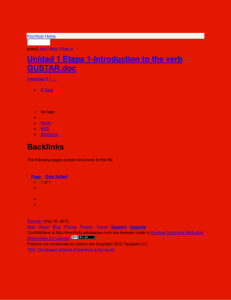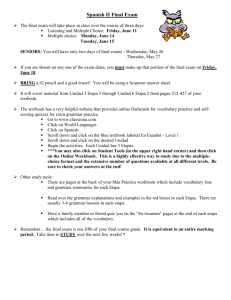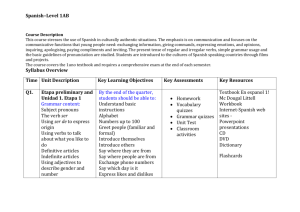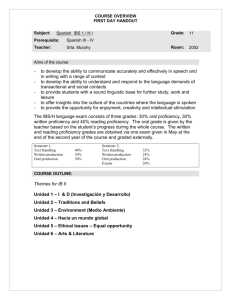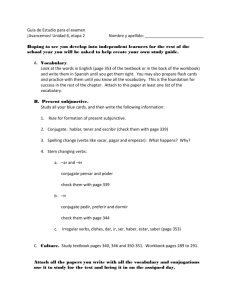Curriculum Guide - Niles Township High School District 219
advertisement
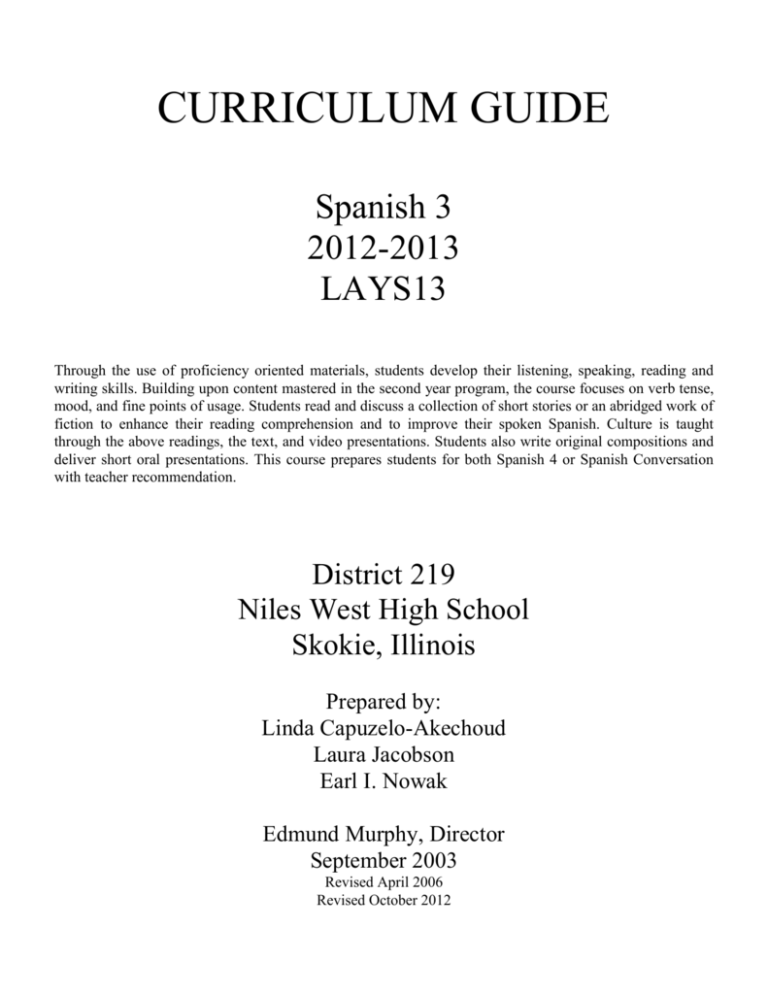
CURRICULUM GUIDE Spanish 3 2012-2013 LAYS13 Through the use of proficiency oriented materials, students develop their listening, speaking, reading and writing skills. Building upon content mastered in the second year program, the course focuses on verb tense, mood, and fine points of usage. Students read and discuss a collection of short stories or an abridged work of fiction to enhance their reading comprehension and to improve their spoken Spanish. Culture is taught through the above readings, the text, and video presentations. Students also write original compositions and deliver short oral presentations. This course prepares students for both Spanish 4 or Spanish Conversation with teacher recommendation. District 219 Niles West High School Skokie, Illinois Prepared by: Linda Capuzelo-Akechoud Laura Jacobson Earl I. Nowak Edmund Murphy, Director September 2003 Revised April 2006 Revised October 2012 This guide may be changed at any time at the sole discretion of the Board of Education and/or the Superintendent, whichever has appropriate jurisdiction, subject only to mandatory collective bargaining requirements. Table of Contents Course Outcomes.................................................................................................................3 Vocabulary Benchmarks and Corresponding Activities......................................................9 Grammar Benchmarks and Corresponding Activities.......................................................13 Culture Benchmarks and Corresponding Activities..........................................................18 Technology Standards and Corresponding Activities.......................................................21 Sample of Syllabus............................................................................................................23 Sample of Quiz..................................................................................................................24 Summary Chart of Course Topics.....................................................................................25 LEARNING TARGETS – SPANISH 3 (1st Semester) Over-arching Reading Target: I can comprehend (at a literal level) a passage of prose-fiction or nonfiction, containing structures and vocabulary presented in the course. IV Over-arching Vocabulary Target: I can recognize and use vocabulary contained in ¡En Español tres!. I can recognize and use vocabulary from Etapa Premliminar I can recognize and use vocabulary from Unidad 1 Etapa 1 I can recognize and use vocabulary from Unidad 1 Etapa 2 I can recognize and use vocabulary from Unidad 1 Etapa 3 I can recognize and use vocabulary from Unidad 2 Etapa 1 I can recognize and use vocabulary from Unidad 2 Etapa 2 Over-arching Verb Target: I can recognize a variety of verbs. I can recognize and use regular and irregular forms in the present tense. I can recognize and use regular and irregular forms in the preterite tense. I can recognize and use reflexive verbs. I can differentiate between ser and estar. I can recognize and use regular and irregular forms in the imperfect tense. I can differentiate between the uses of preterite and imperfect tenses. I can recognize and use present and past perfect tenses. I can recognize and use gustar-like verbs. I can recognize and use regular and irregular familiar (tú) imperative forms. I can recognize and use regular and irregular formal (Ud.) imperative forms. I can recognize and use regular and irregular forms of the present subjunctive. I can recognize and use the present subjunctive with impersonal expressions. Over-arching Usage Target: I can recognize and use grammatical structures. I can recognize and use the reciprocal reflexive. I can recognize and use the passive se. I can recognize and use direct object pronouns. I can recognize and use indirect object pronouns. I can recognize and use double object pronouns. V Over-arching Culture Target: I can recognize cultural topics appearing in ¡En español tres!. VI Over-arching Listening Target: I can respond to comprehension questions based on a listening passage commensurate in difficulty with the outcomes of the course. VII Over-arching Speaking Target: I can participate actively in oral discourse, using strings of sentences that begin to resemble short, organized paragraphs rather than simple, disjointed sentences. LEARNING TARGETS – SPANISH 3 (2nd Semester) Over-arching Reading Target: I can comprehend (at a literal level) a passage of prose-fiction or nonfiction, containing structures and vocabulary presented in the course. Over-arching Vocabulary Target: I can recognize and uses vocabulary contained in ¡En Español tres!. I can recognize and use vocabulary from Unidad 2 Etapa 3 I can recognize and use vocabulary from Unidad 3 Etapa 1 I can recognize and use vocabulary from Unidad 3 Etapa 2 I can recognize and use vocabulary from Unidad 3 Etapa 3 I can recognize and use vocabulary from Unidad 4 Etapa 1 I can recognize and use vocabulary from Unidad 4 Etapa 2 I can recognize and use vocabulary from Unidad 4 Etapa 3 I can recognize and use vocabulary from Unidad 5 Etapa 1 I can recognize and use vocabulary from Unidad 5 Etapa 2 Over-arching Verb Target: I can recognize a variety of verbs. I can recognize and use regular and irregular forms in the future tense. I can recognize and use subjunctive with nonexistent and indefinite situations. I can recognize and use subjunctive with disagreement and denial. I can differentiate between the subjunctive and the indicative moods. I can recognize and use the forms of the present progressive with ir, andar, seguir. I can recognize and use the forms of the past progressive. I can recognize and use regular and irregular first person plural (nosotros) imperative forms. I can recognize and use regular and irregular forms of the present perfect subjunctive. I can differentiate between present subjunctive and indicative with expressions of emotion. I can differentiate between present subjunctive and indicative with expressions of doubt and uncertainty. I can differentiate between present subjunctive and indicative with conjunctions of time. I can recognize and use present subjunctive with expressions of hope and desire. I can recognize and use present subjunctive with conjunctions of contingency. Over-arching Usage Target: I can recognize and use grammatical structures. I can recognize and use interrogative words. I can recognize and use affirmative and negative expressions. I can recognize and use possessive pronouns. I can recognize and use demonstrative adjectives and pronouns. I can recognize and use relative pronouns. Over-arching Culture Target: I can recognize cultural topics appearing in ¡En español tres!. Over-arching Listening Target: I can respond to comprehension questions based on a listening passage commensurate in difficulty with the outcomes of the course. Over-arching Speaking Target: I can participate actively in oral discourse, using strings of sentences that begin to resemble short, organized paragraphs rather than simple, disjointed sentences. Addendum Culture: I can recognize the following cultural topics appearing in ¡En español tres!. Hispanics in Miami Fashion in U.S. & Hispanoamérica El Mambo-Tito Puente Guatemala-Rigoberta Menchú Nicaragua: environment & ecology Costa Rica and national parks Graduation in Latin America Puerto Rico Columbus Day Abolition of Slavery Government, patriotism Argentina: Jorge Luis Borges Uruguay, Chile, Paraguay Isabel Allende Spanish traditions Pre-Columbian civilizations Arquitecture Speaking : I can participate actively in oral discourse, using strings of sentences that begin to resemble short, organized paragraphs rather than simple, disjointed sentences. Responds in detail to personal questions regarding oneself, family, classmates. Asks others for information about themselves, family, occupation, education, recreation, pastimes, et al. Describes the action (activities) depicted in a set of visual stimuli. Narrates and describes events using indicative tenses. Recounts a sequence of events that had happened to him/her or to someone else. Summarizes a movie, T.V. program, book, magazine article, et al. Discusses a familiar situation/topic (perhaps school related) and expresses an opinion in simple, factual terms. Asks series of questions for a variety of purposes. Seeks factual information. Elicits the opinion of teacher and classmates. Clarifies the statements and opinions of teacher and classmates on a variety of topics (e.g., literary analysis). Reports on or summarizes cultural information disseminated in class. Compares/contrasts cultural differences when given a specific concept from the instructor. Responds in detail to personal questions regarding oneself, family, classmates. Asks others for information about themselves, family, occupation, education, recreation, pastimes, et al. Describes the action (activities) depicted in a set of visual stimuli. Narrates and describes events using indicative tenses. Recounts a sequence of events that had happened to him/her or to someone else. Summarizes a movie, T.V. program, book, magazine article, et al. Discusses a familiar situation/topic (perhaps school related) and expressesan opinion in simple, factual terms. Discusses plans for a future event. Asks series of questions for a variety of purposes. Seeks factual information. Elicits the opinion of teacher and classmates. Clarifies the statements and opinions of teacher and classmates on a variety of topics (e.g., literary analysis). Reports on or summarizes cultural information disseminated in class. Compares/contrasts cultural differences when given a specific concept from the instructor. Vocabulary themes, benchmarks, and activities Spanish 3 Theme Unidad 1/Etapa 1 Describing people Unidad 1/Etapa 2 a. Fashion & accessories b. Pastimes Unidad 1/Etapa 3 a. Household chores b. Expressing feelings Unidad 2/Etapa 1 a. People, places, things b. Saying what you want to do Unidad 2/Etapa 2 a. Environment b. Environmental problems & solutions c. Nature Unidad 2/Etapa 3 a. Wilderness: animals & birds b. Camping, weather Unidad 3/Etapa 1 Graduation Unidad 3/Etapa 2 Food, holidays Benchmarks using Illinois standards 28.B.3a Respond to open-ended questions and initiate communication in various situations. 28.B.3b Produce language with improved pronunciation, intonation and inflection. 28.B.4a Engage in extended conversations in a variety of situations. All benchmarks from preceding section. Activities in text Pgs. 33, 34-35, 36-37 All benchmarks from preceding sections. a. Pgs.76-77, 78-79, 80-81 b. P.85 All benchmarks from preceding sections. a. Pgs.104-105, 106-107, 108109 b. Pgs.111, 113 All benchmarks from preceding sections, and also: 28.B.5a Discuss and defend a position on an issue in a discussion. 30.A.4c Use the target language to analyze the impact of human activity on the natural environment in areas where the target language is spoken. a. Pgs.126-127, 128-129 b. Pgs.130-131, 136, 140-141 c. P.139 All benchmarks from preceding sections, and also: 30.A.1c Use target language to identify simple science terms referring to weather and nature. a. Pgs.148-149, 150-151, 152153, 164-165 b. Pgs.159-160 All benchmarks from preceding sections, and also: 30.B.3b Use the target language to explain in detail the preparation for and activities of specific careers in which the target language can be used. All benchmarks from preceding sections, and also: 29.A.3 Demonstrate selected customs, manners and traditions in societies associated with the target language. 30.A.4d Use the target language to describe and compare daily diet, nutrition and physical fitness regimens in areas where the target language is spoken. Pgs.176-177, 178-179, 180-181 a. Pgs.54-55, 58-59, 68-69 b. Pgs.56-57, 65 Pgs.198-199, 200-201, 202-203, 210-211 Unidad 3/Etapa 3 a. Columbus Day b. Abolition of slavery c. Government/patriotism All benchmarks from preceding sections, and also: 29.D.4 Compare and contrast the influences of historical figures and events and their impact on the development of their countries. Unidad 4/Etapa 1 a. Course work b. Abilities, experience Unidad 4/Etapa 2 a. Professions b. Workplace Unidad 4/Etapa 3 a. Careers, industries b. Statistics All benchmarks from preceding sections. Unidad 5/Etapa 1 Art, paintings, dance Unidad 5/Etapa 2 a. Crafts, dances b. The New World All benchmarks from preceding sections, and also: 30.B.3a Use the target language to identify and describe occupations unique to areas where the target language is spoken. All benchmarks from preceding sections, and also: 30.B.4a Use the target language to compare various occupations in terms of their roles, status and qualifications in areas where the target language is spoken and in the United States. 30.B.4b Use the target language to analyze connections between specific businesses and industries in areas where the target language is spoken and in the United States. All benchmarks from preceding sections, and also: 29.B.3a Identify and explain ideas and themes expressed in selected works of art associated with target language societies using terms from the target language. 29.B.3b Understand and use the essential target language vocabulary referring to tools, processes and products in one or more of the art forms. 29.B.4a Compare themes that are inherent to areas where the target language is spoken as expressed in different art forms. 29.B.4b Compare and contrast selected art forms of areas where the target language is spoken. 29.B.5a Explain the cultural and historical significance of characteristic art forms of a target language society. All benchmarks from preceding sections. a. Pgs.220-221, 222-223, 236237 b. Pgs.220-221 c. Pgs.220-221, 224-225, 229, 230-231 a. Pgs.248-249, 250-251, 255 b. Pgs.252-253 a. Pgs.270-271, 274-275 b. Pgs.272-273, 282-283 a. Pgs.292-293, 294-295, 296, 299 b. Pgs.297, 303, 305 Pgs.320-321, 322-323, 324-325, 327, 329, 332 a. Pgs.344-345, 349, 351 b. Pgs.342-343, 346-347 Grammar themes, benchmarks, and activities Spanish 3 Theme Unidad 1/Etapa 1 a. Direct object pronouns b. Present and past perfect Benchmarks using Illinois standards Activities in text 28.A.1a Recognize basic language patterns. a. (AMSCO) 28.A.1b Respond appropriately to simple commands in the target language. b. P. 45 28.A.2a Comprehend illustrated stories, audiovisual programs, or websites. 28.A.2b Follow instructions in the target language, given one step at a time for a wide range of activities. 28.A.3a Comprehend main messages of simple oral and audio presentations with assistance from resources. 28.B.1a Respond to and ask simple questions with prompts. 28.B.1b Imitate pronunciation, intonation, and inflection, including sounds unique to the target language. 28.B.2a Pose questions spontaneously in structured situations. 28.B.2b Produce language using proper pronuciation, intonation, and inflection. 28.C.1a Recognize the written form of familiar spoken language and predict meaning of key words in a simple story, poem or song. 28.C.1b Infer meaning of cognates from context. 28.C.2a Comprehend written classroom directions, read simple passages, infer meaning of cognates, and recognize loan words. 28.C.2b Decode new vocabulary using contextual clues and drawing on words and phrases from prior lessons. 28.D.1a Copy/write words, phrases, and simple sentences. 28.D.1b Describe people, activities, and objects from school and home. 28.D.2a Write on familiar topics using appropriate grammar, punctuation, and capitalization. 28.D.2b Present a simple written or oral report on familiar topics. 28.D.2c Present an original production using known vocabulary and grammatical structures. Unidad 1/Etapa 2 a. Indirect object pronouns b. Future tense c. Future of probability 29.A.1 Use common forms of courtesy, greeting, and leave-takings appropriate to the time of day and relationship. 28.A.3b Follow instructions in the target language as given in multi-step segments for assignments and activities in and out of the classroom. 28.B.3a Respond to open ended questions and initiate communication in various situations. 28.B.3b Produce language with improved pronunciation, intonation, and inflection. 28.C.3b Compare word use, phrasing and sentence structures of the target language with those used in one or more other languages. 28.D.3c Present a simple, original poem or story based on a model. 28.A.4 Comprehend details of oral and audio presentations unsupported by visual aids. 28.B.4b Express differences of meaning using proper pronunciation , intonation and inflection. 28.B.4c Recognize and use nonverbal cues in various formal and informal settings. 28.C.4a Comprehend key vocabulary as well as the main message of complex written materials without the help of visuals. 28.C.4b Demonstrate understanding of written materials by organizing information and concepts (e.g., outlines, flow charts). 28.D.4c Present a short original piece (e.g., essay, story, poem) on a given theme with some guidelines. 29.A.4 Demonstrate target language expressions and levels of formality (e.g., age, social status) appropriate for entry-level work and social situations. 29.B.4a Compare themes that are inherent to areas where the target language is spoken as expressed in different art forms. 29.B.4b Compare and contrast selected art forms of areas where the target language is spoken. 29.C.4b Describe characteristics, origins and authors of various literary forms using target language vocabulary. All benchmarks from preceding section. a. (AMSCO) b. Pgs.. 64-65 c. Pgs.. 66-67 Unidad 1/Etapa 3 a. Double object pronouns b. Reciprocal reflexives c. Saber vs. conocer Unidad 2/Etapa 1 a. Pronoun placement with commands Unidad 2/Etapa 2 a. Present perfect subjunctive b. -uir (y) verbs in present subjunctive All benchmarks from preceding sections. a. (AMSCO) b. Pgs.. 85-89 c. Teacher-created activities All benchmarks from preceding sections. a. Pgs.. 111-114 All benchmarks from preceding sections. a. Pgs.. 138-139 b. Teacher-created activities Unidad 2/Etapa 3 a. Subjunctive with "cuando" and conjunctions of time b. -cer verbs (z) in subjunctive Unidad 3/Etapa 1 a. Subjunctive with conjunctions b. Imperfect subjunctive c. -ger (j) in subjunctive Unidad 3/Etapa 2 a. Subjunctive with indefinite and nonexistent antecedents b. Conditional "si" clauses c. Sembrar, recoger, educar spelling changes in subjunctive All benchmarks from preceding sections. a. Pgs.. 159-160 b. Teacher-created activities All benchmarks from preceding sections. a. P. 185 b. Pgs.. 187-188 c. Teacher-created activities All benchmarks from preceding sections. a. Pgs.. 204-205 b. Pgs.. 209-211 c. P. 204 Unidad 3/Etapa 3 a. Subjunctive vs. indicative b. -cer verbs (z), -gar verbs (gu) in subjunctive Unidad 4/Etapa 1 a. Progressive with ir, andar, seguir b. Past progressive Unidad 4/Etapa 2 a. Past perfect subjunctive b. Conditional perfect c. Placement of object pronouns Unidad 4/Etapa 3 a. Future perfect Unidad 5/Etapa 1 a. ¿Qué? vs. ¿cuál? b. Relative pronouns Unidad 5/Etapa 2 a. Relative pronouns All benchmarks from preceding sections. a. Pgs.. 232-233 b. P. 231 and teacher-created activities All benchmarks from preceding sections. a. Pgs.. 258-259 b. Pgs.. 260-261 All benchmarks from preceding sections. a. Pgs.. 279-280 b. Pgs. 282-283 c. P. 279 and teacher-created activities All benchmarks from preceding sections. a. Pgs.. 303-304 All benchmarks from preceding sections. a. Pgs.. 329-330 b. Pgs.. 331-332 All benchmarks from preceding sections. a. Pgs. 352-355 Culture themes, benchmarks, and activities Spanish 3 Theme Unidad 1/Etapa 1 a. Miami b. Cristina García c. Concept of barrio d. Los apodos e. Spanish-speaking immigrants and identity Unidad 1/Etapa 2 a. La Villita b. San Antonio c. La moda-Oscar de la Renta Benchmarks using Illinois standards 29.E.2 Use maps, charts, digital images, graphs and other geographic representations to describe and discuss the countries where the target language is spoken. 29.E.5 Describe how migration, settlement and colonization have affected the economy and environment of country(ies) where the target language is spoken. Activities in text Pgs.43, 46-47, 50 29.B.2a Identify sample art works and their creators associated with areas where the target language is spoken. Pgs.65, 66, 68-69 Unidad 1/Etapa 3 a. Hispanics in the Northeastern U.S. b. Mambo-Tito Puente c. Sandra Cisneros Unidad 2/Etapa 1 a. El Rock b. Nueva Trova-Silvio Rodriguez c. Rigoberta Menchú d. Youth groups in Mexico & CA e. Young people addressing adults f. Castellano Unidad 2/Etapa 2 a. Monteverde, Costa Rica b. Nicaragua 29.B.2b Describe selected art forms of areas where the target language is spoken using arts vocabulary from the target language. Pgs.85, 86, 89, 90-91, 92-93, 96 29.C.2b Identify sample literary works and their authors representative of the target language. 29.A.3 Demonstrate selected customs, manners and traditions in societies associated with the target language. Pgs.114, 116, 118-119, 122 29.E.3 Describe geograhpical aspects (e.g., population distribution, natural resources and main economic activities) of areas where the target language is spoken. Pgs.136, 138, 140-141, 144 Unidad 2/Etapa 3 a. Parque Nacional Volcán Poás b. Los Mayas c. Costa Rica - national parks Unidad 3/Etapa 1 a. Graduation b. Nicolás Guillén 29.E.2, 29.E.3 Pgs.154, 157, 162-163, 164-165, 168 29.A.5 Analyze and interpret manners and customs within the social, academic and work environments of selected target language societies. Pgs.184, 187, 190-191, 194 Unidad 3/Etapa 2 a. La Fortaleza b. Puerto Rico - las máscaras c. Salsa d. Fiestas de Puerto Rico 29.B.4a Compare themes that are inherent to areas where the target language is spoken as expressed in different art forms. 29.A.5 Pgs.205, 207, 209, 212-213, 216 Unidad 3/Etapa 3 a. La República Repúblicana b. Las fiestas, R.D. c. La historia de la R.D. d. José Martí 29.A.5 29.E.2 Pgs.228, 231, 234-235, 236-237, 240 Unidad 4/Etapa 1 a. La educación b. Jorge Luis Borges 29.A.5, 29.C.2b Pgs.257, 258, 259, 262-263, 266 Unidad 4/Etapa 2 a. El ambiente de trabajo b. Los jóvenes y el futuro 29.A.4 Demonstrate target language expressions and levels of formality (e.g., age, social status) appropriate for entry-level work and social situations. 29.A.5 30.B.2a Use the target language to describe activities and characteristics of selected occupations and work places. Pgs.277, 280, 284-285, 288 Unidad 4/Etapa 3 a. Porteño b. Idiomas distintos c. Isabel Allende d. Buscando trabajo Unidad 5/Etapa 1 a. La Sardana b. Barcelona c. Catalán d. Miguel de Unamuno e. Ana María Matute f. Spanish Civil War g. Museo del Prado Unidad 5/Etapa 2 a. Las pirámides b. La Pirámide del Sol c. Luis Barragán 29.C.2b 30.B.2b Use the target language to explain and describe general career choices in which the target language can be used. Pgs.300, 304, 306-307, 308-309, 312 29.D.4 Compare and contrast the influences of historical figures and events and their impact on the development of their countries. 29.C.2b, 29.B.2a Pgs.331, 334-335, 338 29.B.2b 29.B.4b Compare and contrast selected art forms of areas where the target language is spoken. Pgs.349, 350, 354, 356-357, 360 National Educational Technology Standards (NETS) and activities Spanish 3 NETS 1. Basic operations and concepts: Students demonstrate a sound understanding of the nature and operation of technology systems. Students are proficient in the use of technology. 2. Social, ethical, and human issues: Students understand the ethical, cultural, and societal issues related to technology. Students practice responsible use of technology systems, information, and software. Students develop positive attitudes toward technology uses that support lifelong learning, collaboration, personal pursuits, and productivity. 3. Technology Productivity Tools: Students use technology tools to enhance learning, increase productivity, and promote creativity. Students use productivity tools to collaborate in constructing technology-enhanced models, preparing publications, and producing other creative works. 4. Technology communications tools: Students use telecommunications to collaborate, publish, and interact with peers, experts, and other audiences. Students use a variety of media and formats to communicate information and ideas effectively to multiple audiences. Activities: AP = audio program; VP = video program; CD ROM; IN = internet activities IN CD ROM; IN AP; VP; CD ROM; IN Student-created videos; IN 5. Technology research tools: Students use technology to locate, evaluate, and collect information from a variety of sources. Students use technology tools to process data and report results. Students evaluate and select new information resources and technological innovations based on the appropriateness to specific tasks. 6. Technology problem-solving and decision-making tools: Students use technology resources for solving problems and making informed decisions. Students employ technology in the development of strategies for solving problems in the real world. IN IN Español 2/¡En español tres! FECHA lunes martes miércoles jueves viernes TRABAJO EN CLASE TAREA PARA LA CASA Presentar el vocabulario nuevo, p.51 En Contexto, pp.32-33 Preguntas orales Repasar ser y estar, p.38 Actividades 5 y 6, pp.38-39 Nota Cultural, p.38 Escuchar: Actividades 1-4, pp.11-12, MP Repasar el vocabulario y la tarea En Vivo (en parejas) pp.34-35 Preguntas orales Actividades 1 y 2, p.36 Repasar ser y estar Actividades 7 y 8, p.39 Ej. E, pp.112-113, AMSCO Repasar la tarea con ser y estar Repasar el vocabulario y la tarea Actividades 3 y 4, p.37 Video Examencito Repasar las formas del imperfecto, p.40 Actividades 9 y 10, pp.40-41 Repasar el vocabulario y la tarea TEMA Examencito Repasar el imperfecto y la tarea Actividad 11, p.41 Repasar el pretérito vs. el imperfecto, p.41 Actividades 12 y 13, p.42 1 9 1. Actividades 5-12, pp.13-16, Más Práctica 1. Ejs. F y G, pp.113-115, AMSCO 2. Hoja de práctica con el vocabulario 1. Actividades de video 2. Estudiar para el examencito de ser vs. estar para mañana. 1. Actividades 13-16, pp.17-18, Más Práctica 2. Estudiar el vocabulario para un examencito mañana. 1. Ejs. A y B, pp.66-68, AMSCO 2. Leer En Voces, pp.46-47 y contestar todas las preguntas, p.47, ¡En español! Español 3 prueba, vocab.1 ¡En Español! Nombre # A. Escribe la palabra correcta de ¡En Español! Incluye un artículo si es un sustantivo. 1. Una persona que no tiene pelo es...(adj.): 2. Otra manera de decir “el atleta”: 3. El opuesto de “redondo”: 4. Sinónimo de “los anteojos”: 5. Marta tiene los ojos azules pero hoy tiene los ojos verdes. Usa... 6. Para jugar al fútbol, necesitas... 7. Antonio usa ------ para no tener el pelo en la cara. 8. Sinónimo de “gordo”: 9. La camiseta no me queda bien porque es una talla “grande”, necesito una... 10. Otra manera de decir “el pelo”: 11. Ayer el profesor tenía el pelo moreno, hoy tiene el pelo rubio. Su pelo está... B. ¿Cómo se dice? Traduce al español. 12. she looks sophisticated 13. they’re attractive from head to toe 14. we’re not at all vain 15. his birthmark distinguishes him from the rest 2 0 Spanish 3: CURRICULUM KEY EE= ¡En español! Text AMSCO=Spanish 3 years WB=Cuaderno: Más Práctica) AUD/WB=audio program in WB (CD) LL = Language Lab AUD/EE=audio program in text (CD) Video/Laser Disc: La Catrina 1st Semester/Spanish 3 UNIDAD/ETAPA (vocabulary) MATERIAL TO BE COVERED verbs/usage/culture EE WB AMSCO TECHNOLOGY (AUD/WB/LL) 4-5 4-5 1 4 8-9 12-13 20 2-3 4 2-3 11-16 14—21 17-26 79-88 89-98 38-39 40-41 41-43 44-45 15-16 17-18 19 20 (AUD/EE) (La Catrina) 34-35, 39 43, 46-47 Episodio 1 56,57,62 Episodio 2 Etapa preliminar Review Review Vocabulary from Spanish 3-4 Present tense, -ar,-er,-ir verbs Present tense stem changing verbs (u-ue, o-ue, i-ie,e-i) Irregular “yo” verbs ser v. estar Reflexive verbs UNIDAD 1/Etapa 1 Describing people Culture Direct object pronouns Regular preterite Imperfect preterite stem changing verbs Preterite v. imperfect -car,-gar,-zar spell changes in preterite Irregular preterite Hispanics in Miami 237-243 27-30 30 66-71 31-36 37-39 11 LL Lesson 9 46-47 UNIDAD 1/Etapa 2 Fashion and accessories Indirect object pronouns 180-184 Pastimes Present & Past perfect Gustar-like verbs 44-45 60 Culture Fashion in U.S. and Hispanoamérica 68-69 20 25-27 70-75 21-22 LL Lesson 12 2 1 64 Spanish 3: CURRICULUM KEY EE= ¡En español! Text AMSCO=Spanish 3 years WB=Cuaderno: Más Práctica) AUD/WB=audio program in WB (CD) LL= Language Lab AUD/EE=audio program in text (CD) Video/Laser Disc: La Catrina 1st Semester/Spanish 3 UNIDAD/ETAPA (vocabulary) MATERIAL TO BE COVERED verbs/usage/culture EE WB AMSCO TECHNOLOGY (AUD/WB/LL) (AUD/EE) (La Catrina) 78-79, 83 90-91 Episodio 3 UNIDAD1/Etapa3 Household chores Express feelings Culture Double object pronouns Reflexive verbs Reciprocal reflexive verbs Passive voice “se” El Mambo UNIDAD/ETAPA (vocabulary) MATERIAL TO BE COVERED verbs/usage/culture 186-191 89-98 82-83 84-86 87-89 92-93 35-36 37-38 39-40 31-32 EE WB AMSCO TECHNOLOGY (AUD/WB/LL) (AUD/EE) (La Catrina) 45 135-144 41-42 106-107, 111, 116, 118-119 Episodio 4 128-129, 138 Episodio 5 101-105 LL Lesson 1 UNIDAD 2/Etapa 1 People, places, things Tú/Ud. Commands 110-111 Culture/literature Rigoberta Menchú/Guatemala 118-119 LL Lesson 2 UNIDAD 2/Etapa 2 Environment Present subjunctive regular 132-133 53 Environmental Problems & solutions Nature Culture Present subjunctive irregular Present subjunctive stem changing 134-135 135-136 54 55 Subjunctive with impersonal expressions Nicaragua Environment/ecology 145 140-141 106-108 49-50 115-117 LL Lesson 3 2 2 Review for final/CRT’s 2 3 Spanish 3: CURRICULUM KEY EE= ¡En español! Text AMSCO=Spanish 3 years WB=Cuaderno: Más Práctica) AUD/WB=audio program in WB (CD) LL= Language Lab AUD/EE=audio program in text (CD) Video/Laser Disc: La Catrina 2nd Semester/Spanish 3 UNIDAD/ETAPA (vocabulary) MATERIAL TO BE COVERED verbs/usage/culture EE WB AMSCO TECHNOLOGY (AUD/WB/LL) (AUD/EE) (La Catrina) 154-155 61 111-113 57-58 150-151, Episodio 6 63-66 115-117 54-63 183, 187 Episodio 7 201, 205, 209 155, 160 Episodio 8 UNIDAD 2/Etapa 3 In the wild, animals, Subjunctive with expressions of emotion birds, camping, weather Culture Future tense Costa Rica National parks, biological reserves 164-165 162-163 LL Lesson 4 UNIDAD 3/Etapa 1 Vocabulary for Unidad 6/Etapa 1 Subjunctive with expressions of wish, Desire, suggestions Culture Unidad 5/Etapa 1 Tradicìones españolas 110-111 182-183 69-70 318-321 337-350 UNIDAD 3/Etapa 2 Culture Vocabulary Unidad 6 Etapa 2 Subjunctive with doubt & uncertainty-disagreement & denial 433 155-157 206-207 62 Civilizaciones Precolombinas 340-345 352-374 2 4 113-115 73-74 LL Lesson 6 Unidad 5/Etapa 2 2 5 Spanish 3: CURRICULUM KEY EE= ¡En español! Text AMSCO=Spanish 3 years WB=Cuaderno: Más Práctica) AUD/WB=audio program in WB (CD) LL=Language Lab AUD/EE=audio program in text (CD) Video/Laser Disc: La Catrina 2nd Semester/Spanish 3 Episodio 9 UNIDAD 4/Etapa 1 Course work, abilities, experience Interrogative words Present progressive Present progressive with ir, andar, seguir past progressive 254-255 256-257 258-259 260-261 94 93 95 96 268-275 64-69 89-90 251, 255,259 Episodio 10 273, 276, 282 Episodio 11 Culture LL Lesson 8 UNIDAD 4/Etapa 2 Professions Workplace Affirmative/negative expressions Demonstrative adjectives & pronouns Relative pronouns + lo que 276-277 326-327 331-333 101 102-103 104 294-299 286-293 192-201 97-98 Culture LL Lesson 9 UNIDAD 4/Etapa 3 2 6 Vocabulary Unidad 6 Etapa 3 Careers, industries Possessive adjectives-short form Statistics Possessive pronouns 300-301 Culture 308-309 Languages of the Hispanic world Episodio12 111 276-285 LL Lesson 10 Review for Final Exam and CRT 2 7
